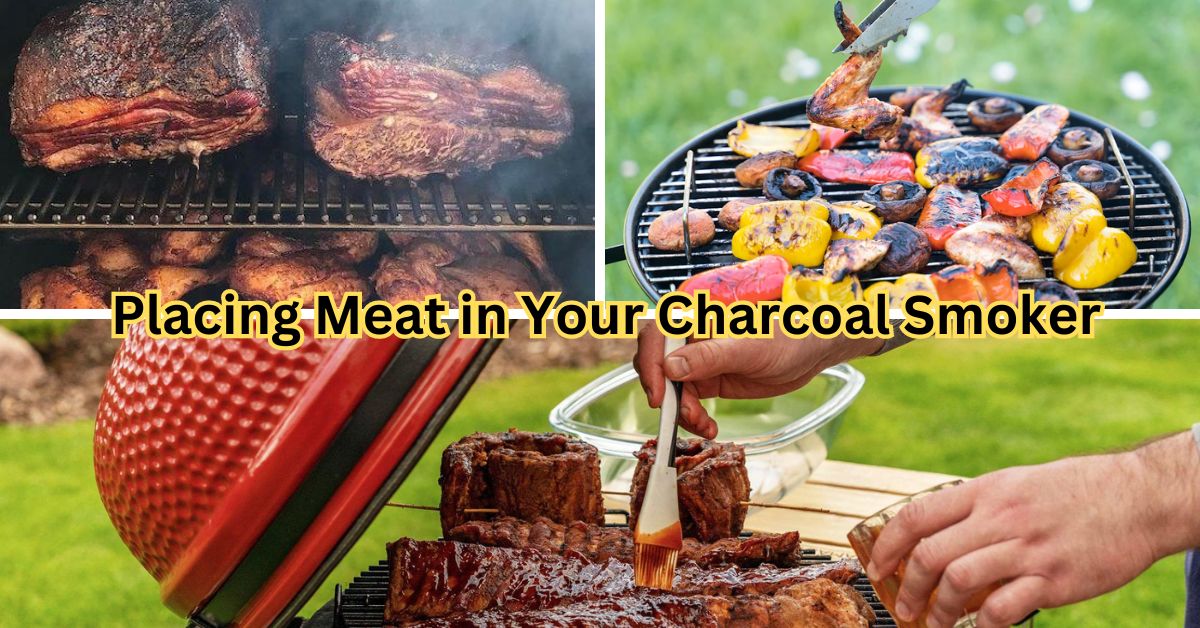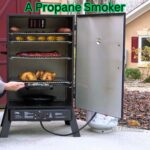As an Amazon Associate, I earn from qualifying purchases.
The secrets of how charcoal smokers work and elevate your BBQ game to new heights. Learn the ins and outs of this traditional cooking method for mouthwatering results every time.
A Guide to Slow-Cooking Meat
How Do Charcoal Smokers Work? -Are you a fan of mouthwatering, tender barbecue? If so, then you’re in for a treat as we delve into the fascinating world of charcoal smokers. In this comprehensive guide, we will walk you through the intricate workings of charcoal smokers, how to prepare your charcoal for optimal results, and the essential components that make up these beloved cooking devices. So sit back, grab a seat by the grill, and get ready to elevate your barbecue game to a whole new level. Let’s get smokin’!
Understanding the Working Principles of Charcoal Smokers
Have you ever wondered how those mouthwatering barbecues are cooked to perfection in charcoal smokers? Let’s dive into the fascinating world of charcoal smokers and uncover the magic behind their slow-cooking prowess. Charcoal smokers operate on the simple yet effective principle of utilizing a combination of charcoal, smoke, and low temperatures to transform tough meat cuts into tender, flavorful BBQ delights. By cooking meat slowly over an extended period, the collagen in the muscle fibers breaks down, resulting in that melt-in-your-mouth texture we all love.
The Key Steps in Using a Charcoal Smoker
To achieve that delectable barbecue taste, several key steps are involved in using a charcoal smoker. It all starts with preparing the charcoal, whether using briquettes or lump charcoal, and arranging them in the smoker to provide indirect heat. The addition of a water pan filled with cool water serves the dual purpose of temperature control and keeping the cooking environment moist. Lighting the charcoal using a chimney or firestarters ensures a clean burn, free from unwanted fuel tastes. The meat is then strategically placed on the grilling grates to take advantage of the indirect heat for even cooking.
From wood chips to temperature control, every detail plays a crucial role in the smoking process. Adding wood chips or chunks to the charcoal infuses the meat with that signature smoky flavor, enhancing its taste profile. Proper temperature control is key to the success of charcoal smoking, achieved through adjusting the vents or dampers to regulate airflow and maintain the ideal cooking temperature range. Monitoring the internal temperature of the meat with a thermometer ensures that it reaches a safe level for consumption. The slow smoking process, lasting anywhere from 6 to 20 hours, allows the flavors to develop and intensify, resulting in tender, mouthwatering BBQ goodness.
With a deeper understanding of the working principles of charcoal smokers, you’re now equipped to elevate your barbecue game to new heights. By following these steps and mastering the art of slow-cooking, you can impress your guests with perfectly smoked meats bursting with flavor. So, fire up that charcoal smoker, get ready to savor the tantalizing aromas, and embark on a flavorful journey that will make you a true pitmaster in your own backyard. Get ready to sizzle, smoke, and indulge in the irresistible world of charcoal-smoked delicacies. Let’s make some magic happen on the grill!
Preparing Charcoal for Your Smoker
Are you ready to fire up your charcoal smoker and start cooking up a storm? Before you get started, it’s essential to prepare your charcoal for optimal results. Here’s a step-by-step guide to help you get your charcoal smoker ready for some mouthwatering barbecue goodness:
Charcoal Selection
Whether you prefer briquettes or lump charcoal, choose high-quality charcoal for the best results. The type of charcoal you use can impact the flavor and cooking process, so pick your favorite and get ready to fire it up.
Arranging the Coals
When loading your charcoal into the smoker, remember not to pack them down tightly. Arrange the coals evenly to allow for proper airflow and consistent heat distribution throughout the cooking process.
Lighting the Charcoal
Avoid using lighter fluid, as it can impart unwanted flavors to your food. Instead, opt for a charcoal chimney or all-natural firestarters to light your charcoal. Once lit, add the hot coals to the rest of the coals in the smoker and let the magic begin.
With your charcoal prepped and ready to go, you’re well on your way to creating delicious barbecue dishes that will have your taste buds dancing with delight. Stay tuned for more tips and tricks on how to make the most of your charcoal smoker and elevate your grilling game to new heights. Get ready to impress your friends and family with expertly smoked meats that will leave them craving more. Let’s fire it up and get cooking!
The Importance of a Water Pan in Charcoal Smoking
When it comes to charcoal smoking, the water pan plays a crucial role in ensuring your meat turns out tender and juicy. Here’s why the water pan is an essential component in the smoking process:
Temperature Regulation: The water pan helps regulate the temperature inside the smoker by absorbing and releasing heat as needed. This ensures a consistent cooking environment for your meat, preventing sudden fluctuations that could affect the final result.
Moisture Retention: By adding water to the pan, you create a humid environment that helps keep the meat moist during the long hours of smoking. This moisture prevents the meat from drying out and becoming tough, resulting in a succulent and flavorful end product.
Flavor Enhancement: The water in the pan can also be infused with herbs, spices, or even fruit juice to add an extra layer of flavor to your meat. As the water evaporates, it carries these flavors into the air, which then penetrate the meat, creating a more complex and aromatic taste profile.
So, next time you fire up your charcoal smoker, don’t forget the importance of the water pan. It’s not just a simple container of water; it’s a key player in the art of smoking meat to perfection. By utilizing the water pan effectively, you can elevate your barbecue game and impress your friends and family with mouthwatering results.

Lighting Charcoal for Optimal Cooking Results
When it comes to lighting charcoal for your smoker, the method you choose can significantly impact the taste and quality of your barbecue. Avoid using lighter fluid, as it can leave a chemical taste on your meat. Instead, opt for a charcoal chimney or all-natural firestarters to ignite your charcoal. The key is to ensure that the coals are evenly lit before adding them to your smoker. This process may take a bit longer, but the end result is well worth the effort.
Properly lit charcoal is essential for achieving consistent heat and optimal cooking results in your smoker. Whether you prefer the convenience of a charcoal chimney or the natural approach of firestarters, the goal remains the same: to create a clean, even burn that imparts a delicious smoky flavor to your meat. Take your time to light the charcoal thoroughly, ensuring that each piece is glowing red, before adding it to your smoker.
The art of lighting charcoal is all about patience and precision. Allow the coals to reach the desired temperature before introducing your meat to the smoking chamber. This waiting period ensures that the charcoal is at its peak heat level, ready to slowly cook your meat to perfection. Remember, the flavor of your barbecue starts with the quality of your charcoal and how well it is ignited.
By mastering the art of lighting charcoal for your smoker, you set the stage for a culinary experience that will impress even the most discerning barbecue enthusiasts. Embrace the process, experiment with different lighting methods, and savor the satisfaction of creating mouthwatering, smoky dishes that will have your guests coming back for more. So fire up that smoker, ignite your charcoal with care, and get ready to elevate your barbecue game to new heights.
Placing Meat in Your Charcoal Smoker
Now that your charcoal smoker is prepped and ready to go, it’s time to tackle the next crucial step: placing the meat on the grilling grates. This is where the magic happens, as the indirect heat and smoky flavors work their wonders on your chosen cuts of meat.
Before you start placing the meat, ensure that the grilling grates are clean and ready for action. This ensures that your meat cooks evenly and doesn’t stick to the grates during the smoking process. Once the grates are good to go, carefully position your meat on them, making sure to leave enough space between each piece for proper air circulation.
If your charcoal smoker comes with multiple racks, opt for the highest one to take advantage of the consistent temperature throughout the cooking process. This ensures that all pieces of meat are cooked evenly and receive the same flavorful treatment from the charcoal and wood smoke. Remember, patience is key when using a charcoal smoker—slow and steady wins the race when it comes to achieving that perfect barbecue flavor.

As you place the meat in your charcoal smoker, keep in mind the importance of airflow and heat distribution. Position the meat strategically to allow the smoke to circulate around each piece, infusing it with the delicious smoky flavor. This step is crucial in ensuring that every bite is packed with that signature barbecue taste that charcoal smokers are known for.
Once the meat is in place, close the lid of the smoker and let the magic happen. Resist the temptation to peek too often, as this can disrupt the cooking process and result in temperature fluctuations. Trust in the process, monitor the temperature, and get ready to savor the mouthwatering results of your charcoal smoking journey. It’s time to sit back, relax, and let the flavors develop to perfection.
Enhancing Flavor with Wood Chips or Chunks
When it comes to taking your barbecue to the next level, adding wood chips or chunks to your charcoal smoker is a game-changer. These flavorful additions create a rich, smoky taste that infuses your meat with a depth of flavor that is hard to resist. So, how can you maximize the use of wood chips or chunks in your charcoal smoker? Let’s explore some key points:
Soaking vs. Dry
While some prefer soaking wood chips or chunks in water before adding them to the charcoal, others opt for using them dry. Experiment with both methods to see which one works best for you and your desired flavor profile.
Type of Wood
Different types of wood impart varying flavors to your meat. From hickory and mesquite to apple and cherry, there is a wide range of options to choose from. Explore different wood varieties to find your perfect match.
Positioning the Wood
Placing the wood chips or chunks directly on the hot charcoal or on a separate tray can affect the intensity of the smoke flavor. Experiment with different placements to achieve your desired level of smokiness.
Monitoring Smoke Levels
Keep an eye on the smoke levels in your charcoal smoker. Too much smoke can overwhelm the meat, while too little may not impart enough flavor. Adjust the amount of wood chips or chunks accordingly to achieve the perfect balance.
By mastering the art of using wood chips or chunks in your charcoal smoker, you can elevate the taste of your barbecue to new heights. Experimentation is key, so don’t be afraid to try different types of wood and techniques to find the perfect combination that suits your palate. Get ready to impress your friends and family with your newfound expertise in creating irresistibly delicious smoked dishes.
Mastering Temperature Control in Charcoal Smoking
Ah, temperature control—the key to unlocking the full potential of your charcoal smoker. As you embark on your smoking journey, mastering the art of regulating the heat within your smoker is crucial for achieving that perfect, mouthwatering barbecue. The vents or dampers on your smoker are your best friends in this culinary adventure, allowing you to fine-tune the temperature to perfection. By adjusting the bottom vents to let in more air and raise the temperature or using the top vent to release excess heat and maintain a steady cooking environment, you can achieve that sweet spot of 220ºF-275ºF (104ºC-135ºC) for optimal results.
But wait, there’s more to temperature control than just opening and closing vents. To truly become a temperature control maestro, you’ll need to pay attention to the subtle nuances of smoking. Keep a watchful eye on your smoker, monitoring the temperature fluctuations and making adjustments as needed. Remember, slow and steady wins the race when it comes to smoking meat; rushing the process by cranking up the heat can result in tough, dry BBQ. So, embrace the slow cooking journey, savor the process, and watch as your meat transforms into a culinary masterpiece.
As you dive deeper into the world of charcoal smoking, don’t forget the importance of patience and precision in temperature control. Each cut of meat has its own unique requirements when it comes to cooking temperatures, so take the time to understand the needs of your chosen protein. Whether you’re smoking a tender rack of ribs or a hearty brisket, adjusting the temperature with finesse will ensure that each bite is packed with flavor and juiciness. So, take a deep breath, trust in your temperature control skills, and let the magic of slow smoking work its delicious wonders on your barbecue.
Temperature control isn’t just about numbers on a dial; it’s about creating an environment where flavors can mingle and meat can transform into a tender delight. By honing your temperature control abilities, you’re not just cooking food; you’re crafting a culinary experience. So, embrace the challenge, experiment with different temperatures and techniques, and let your creativity shine through in every smoky bite. With each successful smoke, you’ll feel a sense of accomplishment and satisfaction, knowing that you’ve mastered the art of temperature control in charcoal smoking—a skill that will elevate your barbecue game to new heights.

Smoking Meat to Perfection in Your Charcoal Smoker
Are you ready to take your barbecue skills to the next level and smoke meat to perfection in your charcoal smoker? Let’s dive into the final step of the process and ensure that your meat turns out tender, juicy, and bursting with flavor. As you embark on this culinary journey, remember that patience is key when it comes to smoking meat. Slow and steady wins the race in the world of charcoal smoking.
Once you’ve set up your charcoal smoker and the meat is in place, it’s time to let the magic happen. Close the lid of the smoker and allow the smoke to work its flavorful wonders on the meat. Remember to periodically check the temperature of the smoker to ensure it stays within the optimal range for smoking. This low- and slow-cooking method will result in meat that is not only delicious but also incredibly tender and juicy.
Depending on the type and size of meat you are smoking, the process can take several hours. It’s essential to resist the temptation to open the lid frequently, as this will disrupt the cooking process and release valuable heat and smoke. Trust in the process and let the smoker work its magic, infusing the meat with mouthwatering flavors that will have your guests coming back for more.
As the meat slowly smokes to perfection, take the time to relax and savor the aromas wafting from your charcoal smoker. The anticipation of that first bite of perfectly smoked meat is part of the joy of charcoal smoking. Once the meat reaches the desired internal temperature, carefully remove it from the smoker and let it rest before slicing and serving. Get ready to impress your friends and family with a sumptuous barbecue feast that showcases your newfound charcoal-smoking skills.
Exploring the Components of Charcoal Smokers
You’ve now uncovered the inner workings of charcoal smokers, from the slow cooking process to the importance of temperature control and flavor enhancement with wood chips. As you explore the various components that make up these versatile cooking devices, you gain a deeper appreciation for the art of barbecue. From the firebox to the water pan, each part plays a crucial role in producing mouthwatering, tender meat that is sure to impress your friends and family.
In conclusion, mastering the art of charcoal smoking requires a combination of patience, skill, and a touch of creativity. By understanding how charcoal smokers work, preparing your charcoal with care, and utilizing the right techniques, you can elevate your barbecue game to new heights. So next time you fire up your smoker, remember these key principles and get ready to savor the delicious flavors of perfectly smoked meat. Happy smoking!

FAQ for How Do Charcoal Smokers Work
How do charcoal smokers work?
Charcoal smokers work by slowly cooking meat over a low, indirect heat created by burning charcoal. The charcoal provides the heat source, while wood chips or chunks are used to add flavor through smoke. A water pan is often used to help regulate the temperature and keep the meat moist during the cooking process.
How do you prepare charcoal for optimal results?
To prepare charcoal for your smoker, you’ll want to arrange the charcoal in a mound or ring, leaving space in the center for airflow. Light the charcoal using a chimney starter or electric starter for even burning. Once lit, wait until the coals are covered in gray ash before adding them to your smoker.
What is the importance of a water pan in charcoal smoking?
A water pan helps regulate the temperature inside the smoker by acting as a buffer between the heat source and the meat. It also adds moisture to the cooking environment, which helps prevent the meat from drying out during the smoking process.
How do you enhance flavor with wood chips or chunks?
To enhance flavor, you can add wood chips or chunks to the charcoal smoker. Soak the wood in water for at least 30 minutes before adding it to the smoker to create a steady stream of smoke. Different types of wood will impart unique flavors to your meat, so experiment with different varieties to find your favorite.
How do you master temperature control in charcoal smoking?
Temperature control in charcoal smoking is achieved by adjusting the airflow vents on the smoker. Opening the vents will increase the heat, while closing them will lower the temperature. Monitoring the temperature with a thermometer and making small adjustments as needed will help you maintain a consistent cooking temperature.
How do you smoke meat to perfection in your charcoal smoker?
To smoke meat to perfection in your charcoal smoker, it’s important to monitor the cooking temperature and the internal temperature of the meat using a meat thermometer. Cook the meat low and slow until it reaches the desired level of doneness, basting or spritzing as needed to keep it moist and flavorful.
What are the essential components of charcoal smokers?
The essential components of charcoal smokers include the firebox, where the charcoal burns; the cooking chamber, where the meat is placed; the water pan, which helps regulate temperature and moisture; and the vents, which control airflow. Understanding how these components work together will help you become a master of charcoal smoking.
As an Amazon Associate, I earn from qualifying purchases.







